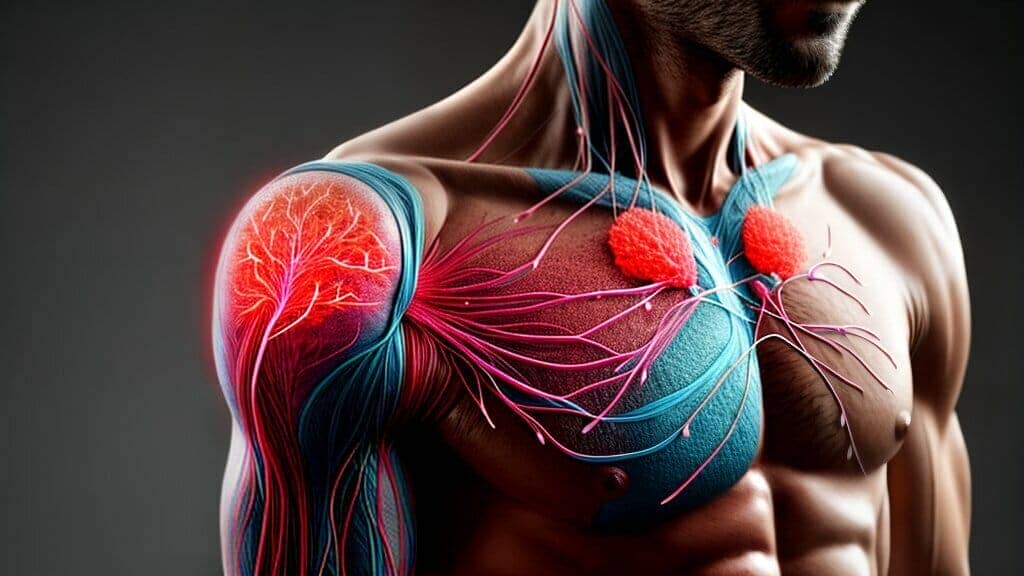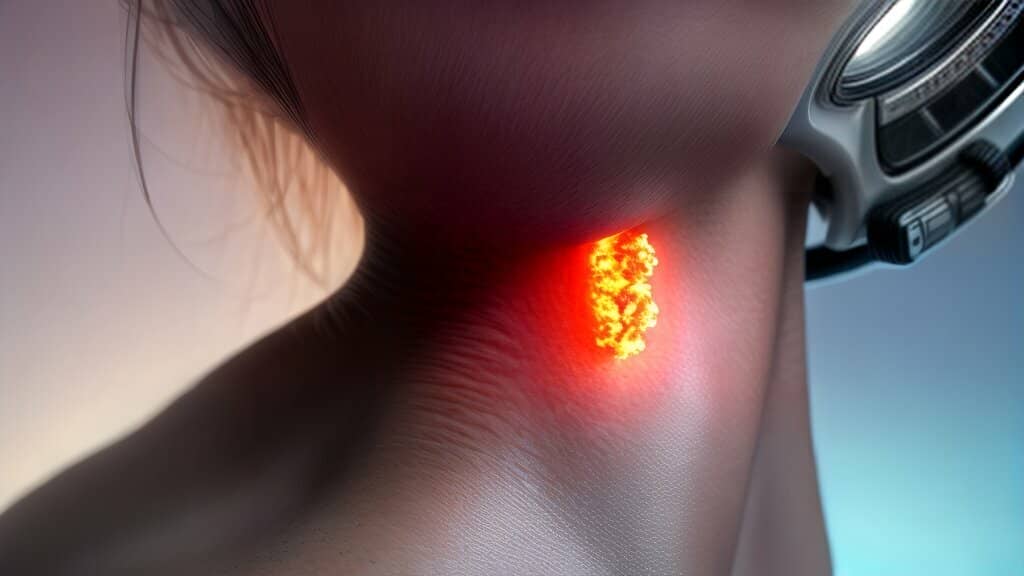Lyme Disease, a tick-borne illness caused by the bacterium Borrelia burgdorferi, affects an estimated 300,000 people in the United States each year. While most people associate Lyme Disease with flu-like symptoms and a bullseye rash, many are unaware of the disease’s connection to the lymphatic system. In this article, we explore the critical link between Lyme Disease and lymph nodes and provide insights into how this connection can impact diagnosis, management, and treatment of the condition.
Key Takeaways:
- Lyme Disease is a tick-borne illness that affects the lymphatic system.
- Lymph nodes play a crucial role in filtering and draining potential pathogens from the body, making them a prime target for Lyme Disease.
- Understanding the connection between Lyme Disease and lymph nodes can aid in diagnosis, management, and treatment of the condition.
Understanding Lyme Disease: Causes and Symptoms
Lyme Disease is a tick-borne illness caused by the bacterium Borrelia burgdorferi. The disease is transmitted to humans through the bite of infected black-legged ticks, commonly known as deer ticks. Lyme Disease is prevalent in the United States, particularly in the Northeast and Midwest regions.
The symptoms of Lyme Disease vary depending on the stage of the disease and can mimic other illnesses, such as the flu. The early stage, known as stage 1 or localized Lyme Disease, is characterized by a bull’s-eye rash at the site of the tick bite and flu-like symptoms, such as fever, fatigue, headache, and muscle aches. In stage 2 or early disseminated Lyme Disease, symptoms can include more pronounced flu-like symptoms, joint pain, and neurological problems, such as facial paralysis and meningitis. In stage 3 or late disseminated Lyme Disease, patients can develop chronic arthritis and neurological symptoms.
It is important to note that not all patients with Lyme Disease will develop the characteristic bull’s-eye rash, making diagnosis more challenging. Additionally, Lyme Disease can be misdiagnosed or undiagnosed, leading to more severe symptoms and long-term health complications.

Early diagnosis and treatment are crucial for successful Lyme Disease management. If left untreated, the disease can progress and cause complications that can be difficult to treat. If you suspect you have been bitten by a tick or are experiencing any of the symptoms associated with Lyme Disease, it is essential to seek medical attention promptly.
The Role of Lymph Nodes in the Body
Lymph nodes play a crucial role in the immune system, helping to filter out harmful substances and organisms from the body. They are part of the lymphatic system, a network of vessels, tissues, and organs that work together to fight infection and disease.
There are hundreds of lymph nodes throughout the body, located in the neck, armpits, groin, and other areas. They are small, bean-shaped structures, typically ranging in size from a few millimeters to a centimeter in diameter. Lymph nodes contain immune cells, such as lymphocytes and macrophages, which help to identify and attack foreign substances that enter the body.
In response to an infection or injury, lymph nodes can become swollen or inflamed, as the immune system ramps up its response to fight off the threat. This can cause pain, tenderness, and discomfort in the affected area. If the infection or injury is severe or prolonged, lymph nodes may become infected themselves, leading to more serious complications.
Overall, healthy lymph nodes are an important indicator of good immune system function, and understanding their role in the body is crucial for maintaining overall health and well-being.

Lyme Disease and Lymph Node Involvement
Lyme Disease is a bacterial infection caused by Borrelia burgdorferi, which is transmitted to humans through the bite of infected black-legged ticks. If left untreated, the bacteria can spread throughout the body, affecting various organs, including the lymph nodes.
When Lyme Disease is left unchecked, it can cause lymph node involvement, leading to swelling and inflammation. The lymph nodes are a crucial part of the immune system, responsible for filtering out harmful substances and fighting infections. In patients with Lyme Disease, the lymph nodes can become enlarged and tender, indicating an infection in the body.
The lymph nodes affected by Lyme Disease are usually those closest to the tick bite, such as those in the groin, armpits or neck. However, in some cases, the bacteria can spread to other lymph nodes in the body, leading to more severe symptoms.
It is essential to seek medical attention if you experience any symptoms of Lyme Disease, including swollen or tender lymph nodes. Early detection and treatment can prevent the bacteria from spreading, reducing the risk of lymph node involvement and other complications.

Recognizing Lymph Node Inflammation in Lyme Disease
When Lyme Disease affects the lymph nodes, it can cause inflammation, swelling, and tenderness. These symptoms are often one of the first signs that Lyme Disease is present in the body. It is essential to recognize these symptoms early on to begin treatment promptly.
The lymph nodes affected by Lyme Disease can be found in various parts of the body, such as the neck, groin, and armpits. Inflammation of these lymphatic structures is a sign that the body is fighting off an infection.
| Signs of Lymph Node Inflammation in Lyme Disease: |
|---|
| Tender to the touch |
| Swollen and enlarged |
| Red or warm to the touch |
| Painful, especially during movement |
If you notice any of these symptoms, it is crucial to seek medical advice as soon as possible. Treatment for Lyme Disease is most effective when administered during the early stages of the disease.

Lyme Disease can be a challenging condition to manage, and lymph node involvement can complicate matters further. Therefore, early diagnosis and management are crucial. By recognizing the signs and symptoms of lymph node inflammation in Lyme Disease, individuals can ensure they receive the necessary treatment to manage their condition effectively.
Diagnosis and Staging of Lyme Disease
Lyme Disease is diagnosed based on a combination of symptoms, medical history, and laboratory tests. The most common test for Lyme Disease is the enzyme-linked immunosorbent assay (ELISA) test, which detects antibodies to the Borrelia burgdorferi bacteria. However, false-negative results may occur, especially in the early stages of the disease.
If the ELISA test is positive, a Western blot test is usually performed to confirm the diagnosis. This test looks for specific antibodies to different proteins of the Borrelia burgdorferi bacteria. A positive Western blot test result confirms the diagnosis of Lyme Disease.
If the diagnosis is still uncertain, a polymerase chain reaction (PCR) test may be performed to detect the DNA of the Borrelia burgdorferi bacteria in the blood or other body fluids. This test is not commonly used for Lyme Disease diagnosis, but it may be helpful in some cases.
It is important to note that Lyme Disease may progress through different stages if left untreated. The early stage is called localized or early disseminated Lyme Disease, which usually occurs within days to weeks after infection. The most common symptom is the characteristic rash that expands from the site of the tick bite. Other symptoms may include fever, fatigue, headache, and muscle aches.
The second stage is called early disseminated Lyme Disease, which occurs weeks to months after infection. The bacteria may spread to other parts of the body, causing symptoms such as joint pain and swelling, heart palpitations, and neurological symptoms.
The late stage of Lyme Disease is called late disseminated Lyme Disease, which may occur months to years after infection. This stage can cause long-term symptoms such as arthritis, chronic fatigue, and neurological problems.
Role of Lymph Nodes in Lyme Disease Diagnosis
The lymphatic system plays a vital role in the diagnosis of Lyme Disease. The Borrelia burgdorferi bacteria can enter the lymphatic system via the tick bite and cause the lymph nodes to swell and become tender. Swollen lymph nodes in the neck, armpit, or groin are common in early disseminated Lyme Disease.
In some cases, a lymph node biopsy may be performed to confirm the diagnosis of Lyme Disease. This involves removing a small sample of the swollen lymph node tissue and examining it under a microscope for evidence of Borrelia burgdorferi bacteria or characteristic changes that suggest the presence of the disease.
It is important to note that not all cases of Lyme Disease involve lymph node swelling and that swollen lymph nodes can occur for many other reasons. Therefore, a lymph node biopsy is not always necessary for Lyme Disease diagnosis and should be considered carefully on a case-by-case basis.

Treatment Options for Lyme Disease
There are a variety of treatment options available for Lyme Disease, including conventional approaches and alternative therapies. The choice of treatment depends on the severity and stage of the disease, as well as individual preferences.
Conventional treatment options for Lyme Disease typically involve a course of antibiotics to target the bacterial infection. The length of the treatment varies based on the stage of the disease and can range from several weeks to several months. It is essential to complete the full course of antibiotics, as stopping early can lead to a recurrence of symptoms.
Alternative therapies can also be beneficial in treating Lyme Disease, especially when combined with conventional treatments. These include:
- Herbal medicine: Some herbs, such as Japanese knotweed, cat’s claw, and Andrographis, have antimicrobial properties and can help boost the immune system.
- Acupuncture: This traditional Chinese medicine technique involves inserting thin needles into specific points in the body to reduce inflammation and pain.
- Nutritional interventions: A healthy diet rich in whole foods and supplements such as probiotics, omega-3 fatty acids, and vitamin D can support the immune system and overall health.
At Oasis Medical Institute, a holistic approach to Lyme Disease treatment is offered, combining conventional medicine with complementary therapies. The comprehensive treatment program includes a personalized nutrition plan, acupuncture, and other supportive therapies to help manage symptoms and improve overall well-being.

It is essential to work with a healthcare provider to determine the best course of treatment for individual cases. Seeking supportive therapies can complement conventional treatment and improve quality of life for people with Lyme Disease.
Oasis Medical Institute: A Holistic Approach to Lyme Disease Treatment
Oasis Medical Institute in Tijuana, MX is a renowned integrative medical center that offers a comprehensive Lyme Disease treatment program. Led by Dr. Francisco Contreras MD, the medical director, the institute combines conventional medicine with complementary therapies to provide personalized and effective treatment to patients.
The Lyme Disease treatment program at Oasis Medical Institute focuses on addressing the root cause of the disease, reducing inflammation, and boosting the immune system. The program includes a range of treatments and therapies, including:
| Treatment | Description |
|---|---|
| Antibiotic therapy | Conventional antibiotics are used to target the Lyme Disease bacteria. |
| Nutritional counseling | Patients receive customized nutrition plans to support their immune system and aid in recovery. |
| Detoxification therapies | These therapies help rid the body of toxins and promote healing. |
| Herbal medicine | Herbs and supplements are used to support immune function and reduce inflammation. |
| Acupuncture | Acupuncture can reduce pain and inflammation and promote relaxation. |
| Massage therapy | Massage can reduce stress, improve circulation, and promote healing. |
| Mind-body therapies | Techniques such as meditation and yoga can help reduce stress and promote relaxation. |
At Oasis Medical Institute, patients receive individualized care based on their unique needs and medical history. The integrative approach to Lyme Disease treatment helps patients achieve optimal health and wellness.

Oasis Medical Institute offers a comprehensive Lyme Disease treatment program that combines conventional medicine with complementary therapies.
The Benefits of a Holistic Treatment Approach
While conventional medicine plays a vital role in treating Lyme Disease, a holistic treatment approach can offer several advantages. Integrating complementary therapies with conventional medicine can help provide a more comprehensive treatment plan that addresses not only the physical symptoms but also the emotional and spiritual aspects of the disease.
For instance, acupuncture has been shown to reduce pain and inflammation, while herbal medicine can help boost the immune system and fight off infections. Nutritional interventions can also improve gut health, which is crucial for individuals with Lyme Disease who often experience digestive issues due to antibiotics.
Moreover, a holistic approach focuses on the underlying causes of the disease, rather than just treating the symptoms. By identifying and addressing the root cause of the disease, it can help prevent future flare-ups and improve overall well-being.
Oasis Medical Institute offers a comprehensive Lyme Disease treatment program that combines conventional medicine with integrative therapies, including acupuncture, herbal medicine, and nutritional interventions. The program is designed to treat the whole person, not just the disease, and provides patients with the support they need to achieve optimal health.
Image source: 
Booking a Consultation at Oasis Medical Institute
If you are interested in learning more about the comprehensive Lyme Disease treatment program offered at Oasis Medical Institute, booking a consultation is the first step. During your initial appointment, you will have the opportunity to discuss your symptoms and medical history with Dr. Francisco Contreras MD, the medical director.
Dr. Contreras will perform a thorough evaluation to determine the extent of your condition and any underlying factors that may be contributing to your symptoms. Based on this assessment, he will develop a personalized treatment plan tailored to your specific needs.
To book a consultation at Oasis Medical Institute, simply call +52 (664) 635 1838 or email [email protected]. Our friendly staff will assist you in scheduling an appointment that fits your schedule.

The Importance of Lyme Disease Prevention
Lyme Disease is a serious condition that can have long-lasting effects on an individual’s health. That is why taking preventative measures to reduce the risk of contracting Lyme Disease is of utmost importance.
One of the most effective ways to prevent the disease is by avoiding tick bites. Individuals can take precautions such as wearing long-sleeved clothing, applying insect repellent, and staying in the middle of trails when hiking or in wooded areas.
It is also important to check for ticks after spending time outdoors, including in your own yard. Ticks can attach themselves to pets, so it is crucial to check your furry friends for ticks as well.
Another preventative measure is to be aware of the symptoms associated with Lyme Disease. This can help individuals recognize the disease in its early stages and seek prompt treatment.
Overall, taking preventative measures is crucial in reducing the risk of contracting Lyme Disease. By being cautious and aware, individuals can protect themselves and their loved ones from this debilitating illness.

Lifestyle Modifications for Lyme Disease Management
While there is no known cure for Lyme Disease, lifestyle modifications can help manage symptoms and improve overall well-being. Making changes to one’s daily routine can have a significant impact on the course of the disease. Here are some tips for managing Lyme Disease through lifestyle modifications:
- Reduce stress: Stress can exacerbate symptoms of Lyme Disease. Practicing relaxation techniques, such as deep breathing, meditation, or yoga, can help reduce stress levels and improve overall well-being.
- Exercise regularly: Even light exercise can help manage symptoms of Lyme Disease, such as fatigue and joint pain. Walking, swimming, or biking are low-impact activities that can be incorporated into one’s daily routine.
- Get adequate rest: Lyme Disease can cause fatigue, which can be worsened by lack of sleep. Getting adequate rest and avoiding overexertion can help manage symptoms and improve overall well-being.
- Eat a healthy diet: A well-balanced diet that is rich in fruits, vegetables, whole grains, and lean protein can help support overall health and reduce inflammation associated with Lyme Disease. Avoiding processed foods and sugar can also help manage symptoms.
By making these lifestyle modifications, individuals with Lyme Disease can help manage symptoms and improve overall well-being as they undergo treatment for the disease.

Supportive Therapies for Lyme Disease
Along with conventional treatment options, individuals with Lyme Disease may benefit from supportive therapies that address various aspects of the condition. These therapies can help manage symptoms, improve immune function, and enhance overall well-being.
Acupuncture: Acupuncture is an ancient Chinese practice that involves inserting thin needles into specific points on the body to stimulate energy flow and promote healing. Studies have shown that acupuncture can reduce pain, inflammation, and fatigue in individuals with Lyme Disease.
| Benefits of Acupuncture for Lyme Disease | |
|---|---|
| Reduces pain and inflammation | Image:  |
| Improves sleep quality | |
| Boosts immune function |
Herbal Medicine: Herbal medicine involves using plant extracts and supplements to promote healing and improve overall health. Certain herbs, such as Andrographis and Astragalus, have been shown to have antimicrobial and immune-enhancing effects that may benefit individuals with Lyme Disease.
| Benefits of Herbal Medicine for Lyme Disease | |
|---|---|
| Has antimicrobial properties | Image:  |
| Supports immune function | |
| Reduces inflammation |
Nutritional Interventions: Nutritional interventions involve modifying or supplementing one’s diet to promote healing and improve overall health. Certain nutrients, such as vitamin C and zinc, have been shown to have immune-boosting effects that may benefit individuals with Lyme Disease.
| Benefits of Nutritional Interventions for Lyme Disease | |
|---|---|
| Supports immune function | Image:  |
| Reduces oxidative stress | |
| Improves energy levels |
It is important to note that supportive therapies should not be used as a replacement for conventional treatments such as antibiotics. These therapies should be used in conjunction with conventional treatments under the guidance of a healthcare professional.
Research and Recent Advances in Lyme Disease
Research into Lyme Disease is ongoing, and new discoveries are constantly being made. One recent advancement is the development of new diagnostic tests that can better detect the disease in its early stages. These tests include the Lyme Multiplex Assay, which can identify multiple strains of the bacteria that causes Lyme Disease. Other promising diagnostic tools include the Lyme Disease C6 Peptide ELISA and the LymeSpot test, which can detect the presence of Lyme Disease antibodies in the blood.
In terms of treatment, recent studies have focused on the use of antibiotics in combination with other therapies, such as hyperbaric oxygen therapy and probiotics. These approaches show promise in reducing the duration and severity of symptoms, as well as improving overall health outcomes for patients with Lyme Disease.
| Recent Research | Findings |
|---|---|
| Clinical Infectious Diseases | Antibiotics combined with hyperbaric oxygen therapy can improve cognitive function in patients with chronic Lyme Disease. |
| Frontiers in Immunology | Probiotics can modulate the immune response and reduce inflammation in patients with Lyme Disease, improving symptoms and overall health. |
| The Journal of Infectious Diseases | Early diagnosis of Lyme Disease is critical for effective treatment and prevention of long-term complications. |
In addition to these advancements, there is also ongoing research into the neurological effects of Lyme Disease and potential treatments for these complications. This includes studies on the use of stem cell therapy and immunomodulatory drugs to improve cognitive function and reduce inflammation in the brain.

Overall, the research and recent advances in Lyme Disease are providing new hope for patients with this condition. By continuing to invest in research and exploring innovative treatment approaches, there is the potential to improve outcomes for those affected by Lyme Disease and ultimately find a cure for this debilitating illness.
Living with Lyme Disease: Coping Strategies and Support
Living with Lyme Disease can be challenging, but there are many coping strategies and sources of support that can help. It is important for individuals with Lyme Disease to take care of their physical and mental health to manage their symptoms and stay healthy.
Self-Care and Lifestyle Modifications
| Tip | Description |
|---|---|
| Reduce stress | Stress can exacerbate Lyme Disease symptoms. Engage in stress-reducing activities such as meditation, yoga, deep breathing, or spending time in nature. |
| Eat a healthy diet | A nutritious diet can help support the immune system and reduce inflammation. Incorporate plenty of fruits, vegetables, and whole grains, and limit processed and sugary foods. |
| Get enough sleep | Getting adequate sleep is crucial for overall health and can help manage Lyme Disease symptoms. Aim for at least 7-8 hours of sleep per night and establish a consistent sleep routine. |
| Stay active | Regular exercise can help improve physical and mental health. Choose low-impact activities such as walking, swimming, or yoga, and listen to your body to avoid overexertion. |
Professional Treatment and Supportive Therapies
Working with a healthcare professional who is knowledgeable about Lyme Disease can help individuals receive appropriate treatment and support. In addition to conventional medical treatments, supportive therapies such as acupuncture, herbal medicine, or nutritional interventions may provide additional benefits.
“Support from friends and family, as well as joining support groups and connecting with others who have Lyme Disease, can help individuals cope with the challenges of the condition.”
Seeking Support and Connection
Support from friends and family, as well as joining support groups and connecting with others who have Lyme Disease, can help individuals cope with the challenges of the condition. Support groups can provide a sense of community and belonging, opportunities to share experiences and information, and emotional support.
- Online Support Groups: There are many online support groups specifically for individuals with Lyme Disease, where members can connect and share information.
- In-Person Support Groups: In-person support groups can provide the opportunity for face-to-face connection and support. Many organizations offer local support groups, such as the Lyme Disease Association.
- Therapy: Working with a therapist who specializes in Lyme Disease or chronic illness can provide additional emotional support and coping strategies.

Image: Lyme Disease Support Group
Conclusion
In summary, Lyme Disease is a complex and multifaceted condition that can have a significant impact on a person’s health and well-being. As we have discussed in this article, there is a clear connection between Lyme Disease and lymph nodes, with the potential for inflammation and swelling to occur.
Understanding the causes and symptoms of Lyme Disease, as well as the role of lymph nodes in the body, is crucial for effective management and treatment. It is also important to recognize the benefits of a holistic approach to Lyme Disease treatment, which can combine conventional medicine with complementary therapies for optimal results.
At Oasis Medical Institute in Tijuana, MX, individuals with Lyme Disease can access comprehensive treatment programs that address the root causes of the condition and support the body’s natural healing processes. With the guidance of Dr. Francisco Contreras MD and his team, patients can develop personalized treatment plans that address their unique needs and goals.
Beyond treatment, there are also various lifestyle modifications, supportive therapies, and coping strategies that can help individuals manage their Lyme Disease symptoms and improve their quality of life. By staying informed and seeking support, individuals with Lyme Disease can take a proactive approach to their health and well-being.
Overall, by recognizing the connection between Lyme Disease and lymph nodes and taking a comprehensive and integrative approach to treatment and management, individuals can optimize their health and well-being in the face of this challenging condition.
FAQ
Q: What is Lyme Disease?
A: Lyme Disease is an infectious disease caused by the bacterium Borrelia burgdorferi and is transmitted to humans through the bite of infected black-legged ticks.
Q: What are the common symptoms of Lyme Disease?
A: Common symptoms of Lyme Disease include fever, headache, fatigue, muscle and joint aches, swollen lymph nodes, and a characteristic skin rash called erythema migrans.
Q: How do lymph nodes function in the body?
A: Lymph nodes play a crucial role in the body’s immune system by filtering and removing harmful substances and infectious agents from the lymphatic fluid.
Q: How does Lyme Disease affect lymph nodes?
A: Lyme Disease can cause swelling and inflammation of the lymph nodes as the body’s immune system responds to the infection.
Q: What are the signs of lymph node inflammation in Lyme Disease?
A: Signs of lymph node inflammation in Lyme Disease may include tender and enlarged lymph nodes in the affected areas of the body.
Q: How is Lyme Disease diagnosed and staged?
A: Lyme Disease is diagnosed through a combination of clinical evaluation, blood tests, and sometimes imaging studies. The disease is also staged based on the progression of symptoms and the presence of complications.
Q: What are the treatment options for Lyme Disease?
A: Treatment options for Lyme Disease may include antibiotics, anti-inflammatory medications, and complementary therapies. At Oasis Medical Institute, a holistic approach to Lyme Disease treatment is offered.
Q: What is the holistic approach to Lyme Disease treatment at Oasis Medical Institute?
A: Oasis Medical Institute offers a comprehensive Lyme Disease treatment program that combines conventional medicine with complementary therapies. Dr. Francisco Contreras MD, the medical director, oversees the treatment process.
Q: What are the benefits of a holistic treatment approach for Lyme Disease?
A: A holistic treatment approach for Lyme Disease can provide a more comprehensive and individualized approach to care, addressing the physical, emotional, and spiritual aspects of the condition.
Q: How can I book a consultation at Oasis Medical Institute for Lyme Disease treatment?
A: To book a consultation at Oasis Medical Institute for Lyme Disease treatment, please call [phone number]. Our team will be happy to assist you.
Q: How can I prevent Lyme Disease?
A: Preventing Lyme Disease can be done by avoiding tick habitats, wearing protective clothing, using insect repellents, and conducting thorough tick checks after potential exposure.
Q: What lifestyle modifications can help manage Lyme Disease symptoms?
A: Lifestyle modifications such as stress reduction, adequate rest, a healthy diet, and regular exercise can help manage Lyme Disease symptoms and improve overall well-being.
Q: Are there supportive therapies for Lyme Disease?
A: Yes, supportive therapies for Lyme Disease, such as acupuncture, herbal medicine, and nutritional interventions, can be used in conjunction with conventional treatment to enhance the healing process.
Q: What are some recent advancements in Lyme Disease research?
A: Recent advancements in Lyme Disease research include new treatment options, improved diagnostic methods, and ongoing studies to further understand the disease and its management.
Q: What coping strategies and support are available for individuals living with Lyme Disease?
A: Coping strategies for individuals living with Lyme Disease include seeking support from healthcare professionals, joining support groups, and practicing self-care techniques.
Dr. Francisco Contreras, MD is a renowned integrative medical physician with over 20 years of dedicated experience in the field of integrative medicine. As the Medical Director of the Oasis of Hope Hospital in Tijuana, Mexico, he has pioneered innovative treatments and integrative approaches that have been recognized globally for the treatment of cancer, Lyme Disease, Mold Toxicity, and chronic disease using alternative treatment modalities. Dr. Contreras holds a medical degree from the Autonomous University of Mexico in Toluca, and speciality in surgical oncology from the University of Vienna in Austria.
Under his visionary leadership, the Oasis of Hope Hospital has emerged as a leading institution, renowned for its innovative treatments and patient-centric approach for treating cancer, Lyme Disease, Mold Toxicity, Long-Haul COVID, and chronic disease. The hospital, under Dr. Contreras's guidance, has successfully treated thousands of patients, many of whom traveled from different parts of the world, seeking the unique and compassionate care the institution offers.
Dr. Contreras has contributed to numerous research papers, articles, and medical journals, solidifying his expertise in the realm of integrative medicine. His commitment to patient care and evidence-based treatments has earned him a reputation for trustworthiness and excellence. Dr. Contreras is frequently invited to speak at international conferences and has been featured on CNN, WMAR2 News, KGUN9 News, Tyent USA, and various others for his groundbreaking work. His dedication to the medical community and his patients is unwavering, making him a leading authority in the field.
Contreras has authored and co-authored several books concerning integrative therapy, cancer, Lyme Disease and heart disease prevention and chronic illness, including "The Art Science of Undermining Cancer", "The Art & Science of Undermining Cancer: Strategies to Slow, Control, Reverse", "Look Younger, Live Longer: 10 Steps to Reverse Aging and Live a Vibrant Life", "The Coming Cancer Cure Your Guide to effective alternative, conventional and integrative therapies", "Hope Medicine & Healing", "Health in the 21st Century: Will Doctors Survive?", "Healthy Heart: An alternative guide to a healthy heart", “The Hope of Living Cancer Free”, “Hope Of Living Long And Well: 10 Steps to look younger, feel better, live longer” “Fighting Cancer 20 Different Ways”, "50 Critical Cancer Answers: Your Personal Battle Plan for Beating Cancer", "To Beat . . . Or Not to Beat?", and “Dismantling Cancer.”





















